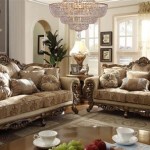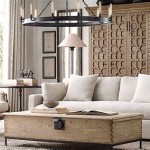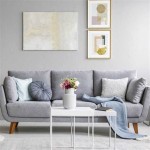Maximizing Extra Living Room Space: Innovative Design Ideas
Many homeowners grapple with the challenge of limited living room space. Clever design strategies are essential to transform a cramped area into a functional and visually appealing environment. This article explores various techniques for maximizing space in a living room, focusing on furniture selection, spatial arrangement, and the incorporation of multi-functional elements.
Strategic Furniture Selection
The choice of furniture significantly impacts the perceived and actual space within a living room. Overly large or bulky pieces can overwhelm a small area, while strategically chosen furniture enhances both functionality and spatial efficiency.
One key consideration is opting for furniture with a smaller footprint. Instead of a large, sprawling sectional sofa, consider a smaller sofa combined with armchairs. This allows for more flexible arrangement options and creates a less imposing presence in the room. Similarly, replace bulky coffee tables with smaller, nesting tables that can be easily tucked away when not needed.
Verticality plays a crucial role in maximizing space. Rather than low, wide cabinets, choose taller, narrower bookcases or shelving units. These utilize vertical space effectively, providing ample storage without occupying significant floor area. Wall-mounted shelves are also an excellent alternative, freeing up valuable floor space and creating an open and airy feel.
Another important aspect is choosing furniture with a lighter visual weight. Glass-topped tables, chairs with slender legs, and furniture upholstered in light-colored fabrics create a sense of openness and prevent the room from feeling cramped. Avoid dark, heavy materials that can make the space feel smaller and more enclosed.
Convertible furniture offers a particularly effective way to maximize space in a living room. Sofa beds provide additional sleeping space for guests without the need for a dedicated guest room. Ottomans with built-in storage offer both seating and hidden storage for blankets, pillows, or other items. These multi-functional pieces are invaluable in making the most of limited space.
Optimizing Spatial Arrangement
The arrangement of furniture is just as important as the furniture itself. A well-planned layout can significantly enhance the functionality and flow of a living room, making it feel more spacious and inviting.
Creating clear pathways is essential for optimizing space. Avoid placing furniture in a way that obstructs movement or creates bottlenecks. Arrange furniture to allow for easy access to doorways and windows, ensuring a smooth flow of traffic throughout the room.
Utilizing the perimeter of the room can free up valuable floor space. Pushing larger pieces of furniture, such as sofas and bookcases, against the walls creates a more open area in the center of the room. This arrangement also makes the room feel larger by maximizing the visible floor space.
Consider creating distinct zones within the living room. For example, a seating area can be defined by a rug and arranged around a focal point, such as a fireplace or television. A separate reading nook can be created in a corner with a comfortable chair and a small table. Dividing the room into distinct zones enhances functionality and prevents the space from feeling cluttered.
Diagonal arrangements can also create a sense of visual interest and make a small room feel larger. Angling furniture, such as a sofa or armchair, can break up the rectangular shape of the room and create a more dynamic and inviting space. This arrangement also redirects the eye, making the room appear less confined.
Mirrors are powerful tools for creating the illusion of space. Placing a large mirror on a wall can reflect light and create a sense of depth, making the room feel significantly larger. Strategically positioned mirrors can also reflect views from windows, bringing the outdoors inside and enhancing the room's ambiance.
Incorporating Multi-Functional Elements
Integrating multi-functional elements is crucial for maximizing space in a small living room. These elements serve multiple purposes, reducing the need for additional furniture and optimizing the use of available space.
Storage solutions are essential for keeping a small living room organized and clutter-free. Built-in shelving units provide ample storage space while blending seamlessly with the room's architecture. Floating shelves offer a more minimalist alternative, providing storage without taking up floor space.
Consider incorporating a media console with built-in storage. This can house electronic equipment, DVDs, and other items, keeping them neatly organized and out of sight. Choose a console with doors or drawers to conceal clutter and maintain a clean and tidy appearance.
Ottomans with lift-up tops or drawers offer hidden storage for blankets, pillows, or other items. These multi-functional pieces provide both seating and storage, making them ideal for small living rooms. Coffee tables with built-in drawers or shelves also offer valuable storage space.
Wall-mounted desks can be folded down when needed and tucked away when not in use. These space-saving desks are perfect for creating a temporary workspace in a living room without sacrificing valuable floor space. Similarly, drop-leaf tables can be expanded for dining or entertaining and folded down when not needed.
Consider the lighting in the living room. Proper lighting can significantly enhance the ambiance and make the space feel larger. Use a combination of ambient, task, and accent lighting to create a layered lighting scheme. Wall sconces and floor lamps can provide task lighting without taking up table space. Recessed lighting can brighten the room without cluttering the ceiling.
Plants can add life and vibrancy to a living room, while also improving air quality. Choose plants that are appropriate for the amount of light available in the room. Hanging plants and wall-mounted planters can add greenery without taking up valuable floor space. Vertical gardens are another excellent option for incorporating plants into a small living room.
Finally, decluttering is essential for maximizing space in a living room. Get rid of items that are no longer needed or used. Donate or sell unwanted items to free up space. Organize remaining items neatly and efficiently. A clutter-free living room will feel significantly larger and more inviting.

Bonus Room Ideas 17 Ways To Maximize An Extra

10 Tips For Styling Large Living Rooms Other Awkward Spaces The Inspired Room

10 Tips For Styling Large Living Rooms Other Awkward Spaces The Inspired Room

10 Tips For Styling Large Living Rooms Other Awkward Spaces The Inspired Room

How To Make The Most Of A Large Living Space Decoholic

20 Creative Home Art Studio Ideas For A Spare Room Extra Space Storage

10 Attic Spaces That Offer An Additional Living Room Decoist

50 Bonus Room Ideas Turn Any Space Into An Office Bar And More
:max_bytes(150000):strip_icc()/WSCoastal_2ndst_017_web-1024x683-1-cc2e265425e8434e93711f831ae78896-a0132e8c5b714d6c9245b25dbee75b7e.jpg?strip=all)
42 Tv Room Ideas For Binge Watching In Comfort And Style

Personalize With These Flex Room Ideas Blog Perry Homes








